| Article ID | Journal | Published Year | Pages | File Type |
|---|---|---|---|---|
| 1531450 | Materials Science and Engineering: B | 2007 | 13 Pages |
Abstract
This study presents a successful preparation of fine powders of strontium ferrite, SrFe12O19, with different contents of SrTiO3 additive (i.e., SrFe12O19 + xSrTiO3, x = 0.00, 0.05, 0.10, 0.15 and 0.20) through a quasi-dry combustion synthesis route using Sr(NO3)2, Fe(NO3)·9H2O, glycine (NH2CH2COOH), and Ti powder as reactants. The synthesis route included mixing and dehydration procedures to produce a flammable, homogenous dried reactant mixture with its subsequent combustion at room temperature to form a voluminous loose product. The as-synthesized powder was calcined at various temperatures to study the effects of temperature on phase development and products' properties. Characterizations of the products were evaluated based on the X-ray diffraction, morphology observations, and magnetic properties studied using various instrumental analyses. Nearly Pure, single magnetic domain SrFe12O19 powder with crystalline size ranging from 55 to 75 nm was produced when x = 0.00 at 1050 °C. It had a maximum intrinsic coercivity (iHc) of 4.92 kOe, a magnetization value (Mmax) of 60.13 emu/g, and a remanence magnetization (Mr) of 34.75 emu/g. Calcination at 1200 °C was found to increase the Mmax to 64.52 emu/g but to decrease the iHc. Experimental results suggested a possible mechanism for the formation of SrFe12O19. The as-synthesized powders and the calcined ones with different x values were introduced into thermal polyurethane (TPU) matrix to prepare a composite. The relative complex permittivity (Ér = Éâ²Â â jÉâ³) and permeability (μr = μâ²Â â jμâ³) of the composite specimens were measured within a frequency range of 1-12 GHz using a network analyzer. Adding SrTiO3 to SrFe12O19 was demonstrated not only to improve the Ér but also to modify the μr. This similar effect was observed when adjusting the calcination temperature.
Keywords
Related Topics
Physical Sciences and Engineering
Materials Science
Electronic, Optical and Magnetic Materials
Authors
Cheng-Shiung Lin, Chyi-Ching Hwang, Ting-Han Huang, Gaw-Pying Wang, Cheng-Hsiung Peng,
